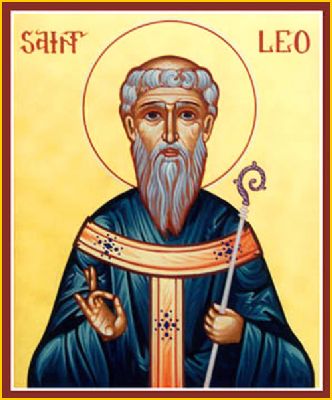|
|||
|---|---|---|---|
| This weekly bulletin insert complements the curriculum published by the Department of Christian Education of the Orthodox Church in America. This and many other Christian Education resources are available at http://dce.oca.org. | |||

The Church celebrates the memory of a saint known for compassion and love toward for the poor, but who is also associated with a shocking act of violence. He is Saint Leo of Catania, in Sicily. Born in 709 in the northern Italian town of Ravenna, Leo became a Benedictine monk at a young age. He spent the next years in Reggio Calabria, at the southern tip of Italy and close to Sicily. Destitute families in the area soon learned that the young monk was a reliable helper, giving them food and money, and encouraging them through his example of prayer and trust in God. When Catania needed a bishop, the people and the nearby bishops immediately thought of Leo. He was consecrated, and continued his work among people in need. But poverty was not the only problem he faced—the island of Sicily and the neighboring parts of Italy were strongly influenced by sorcery, magic and witchcraft. As bishop, he spent many hours working to keep people from placing their hope in these things instead of God. Among the sorcerers in the area was a man named Heliodorus, who could speak convincingly and had a striking appearance. He loved attention; in fact he hoped to dazzle people. There seemed to him to be no way of doing this in his position as a deacon in the Church, so he took up sorcery, and became highly skilled at doing magic tricks that made crowds gasp in amazement. He also claimed that he knew how to cast spells, which inspired fearful admiration in the gullible. Saint Leo attempted with gentle persuasion to turn Heliodorus away from magic and back to faith. He failed, partly because Heliodorus resented his rise to the rank of bishop. As a native of Catania, Heliodorus felt that he should have been the one chosen. Why should a "foreigner" be brought in as bishop, leaving him still a deacon? Heliodorus tried more and more boldly to challenge Saint Leo with his sorcery. Finally one Sunday he interrupted the Liturgy, shouting and flashing his magic tricks to divert people from the service. Saint Leo, for all his patience and compassion, couldn't allow this. He finished the service, and took Heliodorus outside, challenging him to prove his power. Then he built a fire and dragged the magician into it with him. When the fire died down, Leo was unharmed; Heliodorus had been burned to ashes.
The Old Testament (I Kings 18) contains a famous story of similar violence, in which the prophet Elijah destroys the prophets of Baal. Such stories are disturbing, but their point is that God will not permit false teachers to entice people away from Him. He will not let them confuse His people, trying to show that He is not God. When those teachers refuse to repent, as Heliodorus did, God may carry out His warning to destroy their earthly lives so that they can no longer destroy the lives of others with falsehood. |
|||
